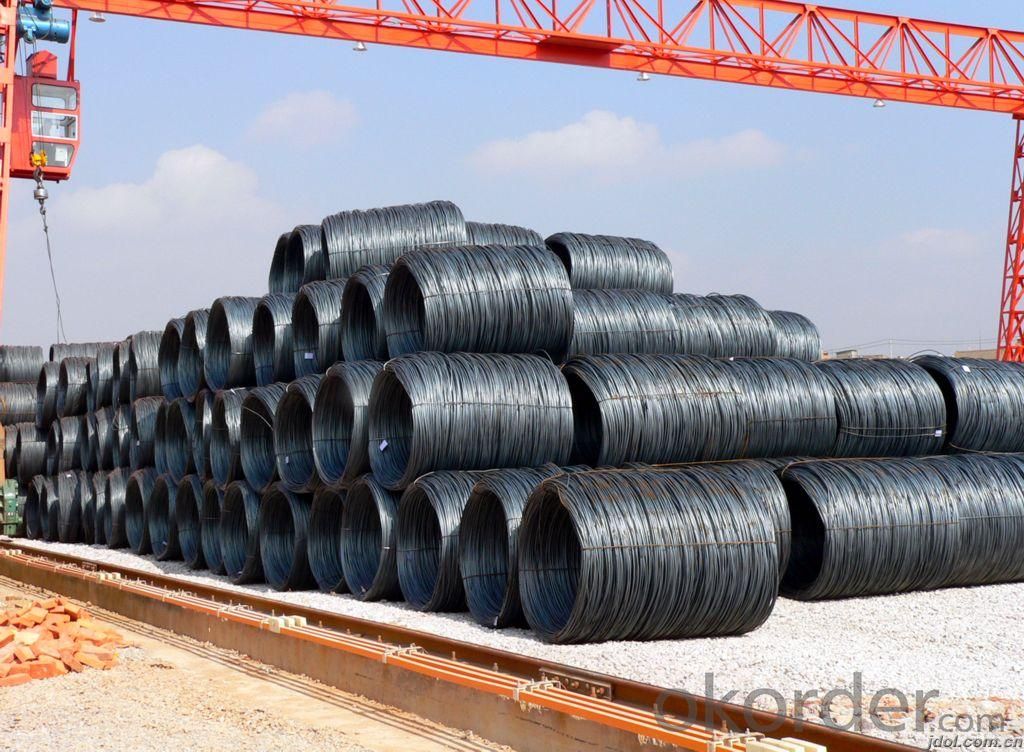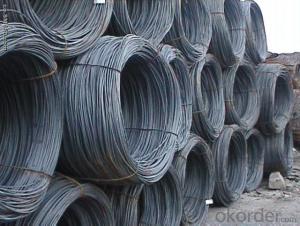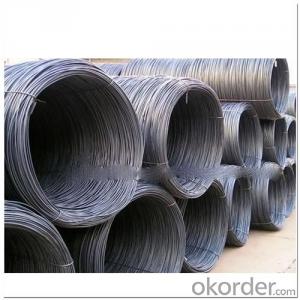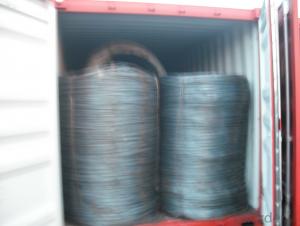Hot Rolled Carbon Steel Wire Rod in Coil
- Loading Port:
- China Main Port
- Payment Terms:
- TT or LC
- Min Order Qty:
- -
- Supply Capability:
- -
OKorder Service Pledge
OKorder Financial Service
You Might Also Like
Product Description:
OKorder is offering Wire Rod at great prices with worldwide shipping. Our supplier is a world-class manufacturer of steel, with our products utilized the world over. OKorder annually supplies products to European, North American and Asian markets. We provide quotations within 24 hours of receiving an inquiry and guarantee competitive prices.
Product Applications:
After hot-rolled the products shaped into coil and delivery as finished product, including round, square, rectangular, hexagonal and so on. Since most of the products are round, it is generally called wire rod. Carbon steel wire rod is widely used in construction and manufacturing. Carbon steel wire rod is mainly used for reinforcement of reinforced concrete and welded structure or reprocessed (roberts , nail, etc.) materials, especially used to produce wire drawing, welding electrode, nails, spring, electronic, precise machinery parts and so on.
.
Product Advantages:
OKorder's Wire Rod are durable, strong, and resist corrosion.
Main Product Features:
· Premium quality
· Prompt delivery & seaworthy packing (30 days after receiving deposit)
· Corrosion resistance
· Can be recycled and reused
· Mill test certification
· Professional Service
· Competitive pricing
Product Specifications:
Steel Grade: Q195/235, SAE1006-1018B Standard: ASTM, GB
Diameter: 5.5mm, 6.5mm, 7mm,8mm,9mm,10mm,12mm,14mm
Type: in coil, coil weight around 2MT Alloy or Not: Alloy
Surface: round, no twisted, light and smooth Chemical Composition: (Please kindly find our chemistry of our material based on Q195、Q235A and Q235B as below for your information)
Trademark | Rank | Chemical composition (quality score) % | |||||
C | Si | Mn | S | P | |||
| ≤ |
| ≤ | ≤ | |||
Q195 |
| 0.06-0.12 | 0.30 | 0.25 | 0.050 | 0.045 | |
Q235 | A | 0.14-0.22 | 0.30 | 0.30-0.65 | 0.050 | 0.045 | |
Q235 | B | 0.12-0.20 | 0.30 | 0.30-0.70 | 0.045 | 0.045 | |
Trademark | Rank | Pulling Test | |||||
Bend PointΔs/Mpa | Tensile Strength | Elongation Ratioδ5% | |||||
Thickness (Diameter) /MM | Thickness (Diameter) /MM | ||||||
≤16 | 16-40 | ≤16 | 16-40 | ||||
≥ | ≥ | ||||||
Q195 |
| 195 | 185 | 315-390 | 33 | 32 | |
Q235 | A | 235 | 225 | 375-500 | 26 | 25 | |
Q235 | B | 235 | 225 | 375-500 | 26 | 25 | |
Note:
1. Our products are produced according to national standard (GB), if not, supply according to national standards (GB) or agreement as customer required.
2. Other Grade and Standard carbon steel wire rod we can supply:
Grade: H08A, 30MnSi, 62B-82B
Standard: AISI, BS, JIS, DIN
The Minimum Order Quantity of these products is high, and need to be confirmed.
3. We can not only supply carbon steel wire rod; if you need anything about building materials, please contact us.
4. Please send us your detail specifications when inquire. We will reply to you as soon as possible. We sincerely hope we can establish a long stable business relationship.
FAQ:
Q1: Why buy Materials & Equipment from OKorder.com?
A1: All products offered byOKorder.com are carefully selected from China's most reliable manufacturing enterprises. Through its ISO certifications, OKorder.com adheres to the highest standards and a commitment to supply chain safety and customer satisfaction.
Q2: How do we guarantee the quality of our products?
A2: We have established an advanced quality management system which conducts strict quality tests at every step, from raw materials to the final product. At the same time, we provide extensive follow-up service assurances as required.
Q3: What makes stainless steel stainless?
A3: Stainless steel must contain at least 10.5 % chromium. It is this element that reacts with the oxygen in the air to form a complex chrome-oxide surface layer that is invisible but strong enough to prevent further oxygen from "staining" (rusting) the surface. Higher levels of chromium and the addition of other alloying elements such as nickel and molybdenum enhance this surface layer and improve the corrosion resistance of the stainless material.
Images:


- Q:What are the potential drawbacks of using steel wire rod?
- Using steel wire rod comes with several potential drawbacks. Firstly, the susceptibility of steel wire rod to corrosion and rusting when exposed to moisture or certain environmental conditions can cause material degradation over time, resulting in reduced strength and structural integrity. Secondly, the relatively heavy nature of steel wire rod compared to other materials can be a disadvantage in applications where weight is a concern. This can make transportation and handling of steel wire rod more challenging and expensive. In addition, steel wire rod may have limited flexibility compared to alternative materials. This can be a disadvantage in situations where the wire needs to be bent or shaped into complex forms or tight spaces. Furthermore, the cost of steel wire rod can be higher compared to other materials, impacting the overall cost of a project. This includes the expenses related to production, transportation, and installation, making it a less economical choice in certain cases. Lastly, steel wire rod may have limitations in terms of its electrical conductivity or magnetic properties, which can be a drawback in applications where these properties are crucial. Considering these potential drawbacks, it is important to carefully evaluate steel wire rod before selecting it for a specific application, despite its numerous advantages such as high strength and durability.
- Q:How are steel wire rods used in the manufacturing of screws and bolts?
- Steel wire rods are used in the manufacturing of screws and bolts as they provide the raw material for shaping and forming these fasteners. The rods are typically cold drawn or hot rolled to produce the required diameter and length for the specific screw or bolt size. They are then cut, threaded, and heat-treated to enhance their strength and durability. Finally, the rods are further processed to create the screw or bolt head, ensuring a secure and reliable fastening solution.
- Q:What are the common steel wire rod manufacturing processes?
- The common steel wire rod manufacturing processes typically involve several steps to transform raw materials into high-quality steel wire rods. The process can vary slightly depending on the specific requirements and desired properties of the wire rod, but the general steps remain consistent. 1. Raw material preparation: The manufacturing process begins with the selection of high-quality raw materials, usually in the form of billets or bars. These materials are carefully inspected and tested to ensure they meet the necessary specifications for strength, composition, and size. 2. Heating: The selected raw materials are heated in a furnace to a specific temperature to make them more malleable and easier to work with. This process is known as heating or preheating. 3. Rolling: The heated billets or bars are then passed through a series of rolling mills to reduce their size and shape them into wire rod form. The rolling process involves a combination of hot rolling, cold rolling, or both, depending on the desired properties and dimensions of the wire rod. 4. Descaling: After the rolling process, the wire rod is often covered with scales or oxides that need to be removed. Descaling is carried out using various methods, such as acid pickling, shot blasting, or mechanical descaling, to ensure a clean surface finish. 5. Cooling: Once the wire rod has been shaped and descaled, it is cooled either naturally or through the use of water sprays or air cooling systems. Cooling is essential to strengthen the wire rod and improve its mechanical properties. 6. Surface treatment: Depending on the intended application, the wire rod may undergo additional surface treatments such as galvanization, coating, or heat treatment to enhance its corrosion resistance, appearance, or other specific properties. 7. Testing and quality control: Throughout the manufacturing process, the wire rod undergoes various quality control checks and testing procedures to ensure it meets the required standards. These include checks for dimensions, tensile strength, surface defects, and other mechanical and chemical properties. 8. Packaging and storage: Once the wire rod has passed all quality control tests, it is typically packaged and stored in a controlled environment to prevent any damage or contamination. Proper packaging and storage ensure that the wire rod remains in excellent condition until it is ready for shipment or further processing. Overall, the common steel wire rod manufacturing processes focus on transforming raw materials into high-quality wire rods by heating, rolling, descaling, cooling, surface treatment, and rigorous quality control measures. These processes are crucial to producing wire rods with the desired mechanical properties, dimensions, and surface finishes for various industrial applications.
- Q:How is steel wire rod used in the manufacturing of wire rope assemblies for lifting equipment?
- Steel wire rod plays a vital role in the production of wire rope assemblies for lifting equipment. To enhance its strength, durability, and resistance to corrosion, the wire rod undergoes a series of mechanical operations, including drawing, annealing, and coating. Once prepared, the wire rod is transformed into individual wires using a stranding process. These wires are then twisted together to form strands, which are further twisted in a helical pattern around a core to create the wire rope. The specific requirements of the lifting equipment determine the number of strands and the direction of twisting. The utilization of steel wire rod in wire rope assemblies guarantees the necessary strength and load-bearing capacity for lifting heavy objects. Steel wire possesses exceptional tensile strength, enabling it to withstand high loads and maintain structural integrity even in extreme conditions. Additionally, the flexibility and malleability of steel wire make it easily adaptable to various shapes and configurations, making it suitable for diverse lifting applications. Wire rope assemblies crafted from steel wire rod find extensive use across industries such as construction, mining, oil and gas, and manufacturing. They are commonly employed in cranes, elevators, hoists, winches, and other lifting equipment to move heavy loads safely and efficiently. The reliable and robust nature of wire rope assemblies ensures the safety of workers and the integrity of the equipment, establishing them as an integral component in the lifting industry.
- Q:How is steel wire rod used in the manufacturing of reinforcing bars?
- Rebar, also known as reinforcing bars, is manufactured using steel wire rod. This essential component is widely used in the construction industry to enhance the strength and durability of concrete structures. The manufacturing process of reinforcing bars involves several steps. Initially, the wire rod is cleansed to eliminate impurities and contaminants. It is then heated and passed through a series of rollers to achieve the desired diameter and shape, a process known as hot rolling. Once the wire rod is shaped, it undergoes cooling and a process called quenching and tempering. This involves rapidly cooling the steel to increase its hardness and strength, followed by tempering to decrease brittleness and improve toughness. This heat treatment procedure ensures that the reinforcing bars possess the necessary mechanical properties to withstand the forces and stresses they will encounter during construction. After shaping and heat treatment, the wire rod is cut into specific lengths to produce individual reinforcing bars. These bars can be further processed by fabrication into various shapes, such as straight bars, bent bars, or stirrups. Alternatively, they can undergo threading or welding, depending on the specific requirements of the construction project. The utilization of steel wire rod in the manufacturing of reinforcing bars is vital as it provides the strength and structural integrity needed to reinforce concrete structures. The wire rod's high tensile strength enables the reinforcing bars to resist forces such as tension, compression, and bending, thereby enhancing the overall strength and stability of concrete structures. Furthermore, the wire rod's ductility and toughness contribute to the rebar's ability to absorb and distribute stress, preventing cracks and failures in the concrete. In conclusion, steel wire rod plays a crucial role in the manufacturing of reinforcing bars. Through shaping, heat treatment, and fabrication, it ensures that the resulting reinforcing bars possess the required strength, durability, and mechanical properties to effectively reinforce concrete structures.
- Q:How are steel wire rods used in the manufacturing of concrete reinforcements?
- Due to their exceptional strength and durability, steel wire rods are commonly utilized in the production of concrete reinforcements. These rods are typically crafted from carbon steel, which is renowned for its outstanding tensile strength. To enhance their properties, steel wire rods undergo a series of mechanical and heat treatments during the production of concrete reinforcements. These treatments, including drawing, annealing, and quenching, result in a material that possesses improved hardness and ductility. After being processed, the steel wire rods are cut into various lengths and shapes to meet the specific reinforcement requirements of the concrete structure. Wire mesh, welded wire fabric, and reinforcing bars (rebars) are typical products manufactured using these rods. Wire mesh and welded wire fabric are commonly employed to reinforce concrete slabs, walls, and foundations. Placed within the concrete formwork, they provide additional strength and prevent cracking or shifting during the curing and loading processes. Rebars, on the other hand, are utilized to reinforce concrete structures that necessitate higher load-bearing capacities. These include columns, beams, and structural frames. By bending and shaping the steel wire rods into configurations such as straight bars, U-shaped bars (stirrups), or spiral shapes, they can be embedded within the concrete structure. These rebars function as tension members, offering resistance against forces that may cause the concrete to crack or fail under a heavy load. In conclusion, steel wire rods are vital components in the production of concrete reinforcements. They contribute strength, durability, and flexibility to concrete structures. With their high tensile strength, they enhance the overall structural integrity and load-bearing capacity, making them indispensable in contemporary construction practices.
- Q:What are the main challenges in recycling steel wire rod?
- The main challenges in recycling steel wire rod include the presence of contaminants, such as coatings or impurities, which need to be removed to ensure the quality of the recycled material. Additionally, the physical characteristics of steel wire rod, such as its shape and length, can make it difficult to handle and process efficiently during recycling. Lastly, the high energy requirements for melting and reshaping steel wire rod pose a challenge in terms of cost and environmental impact.
- Q:How is steel wire rod used in the manufacturing of pre-stressed concrete?
- Steel wire rod is an essential component in the manufacturing of pre-stressed concrete. Pre-stressed concrete is a type of concrete that has been reinforced with steel cables or bars to enhance its structural strength and durability. Steel wire rod is commonly used as the primary material for producing these steel cables or bars. In the manufacturing process, steel wire rods are first drawn through a series of dies to reduce their diameter and increase their tensile strength. This process, known as cold drawing, results in a smooth and consistent wire with a high strength-to-weight ratio. The wire rod is then wound into coils for easy handling and transportation. To create pre-stressed concrete, the steel wire rod is further processed into strands or individual wires. These strands or wires are then embedded into the concrete structure before it sets. The steel wires are tensioned using hydraulic jacks, applying a force that is greater than the anticipated load the concrete will experience during its service life. This tensioning process helps to counteract the tensile stresses that concrete naturally experiences, making it more resistant to cracking and deformation. By incorporating steel wire rods into pre-stressed concrete, the overall strength and durability of the structure are significantly improved. The steel wires act as a reinforcement, providing additional strength to the concrete and allowing it to withstand higher loads and resist cracking. This is particularly useful in applications such as bridges, buildings, and other infrastructure projects where the concrete needs to bear heavy loads or endure challenging environmental conditions. Furthermore, pre-stressed concrete structures are more cost-effective compared to traditional reinforced concrete. The use of steel wire rod reduces the need for additional reinforcement, such as steel bars, resulting in a lighter and more efficient structure. The reduced weight also facilitates faster construction and lower transportation costs. In conclusion, steel wire rod plays a crucial role in the manufacturing of pre-stressed concrete. It is used to create steel cables or bars that are embedded in the concrete structure, enhancing its strength, durability, and load-bearing capacity. By incorporating steel wire rods, pre-stressed concrete structures can withstand higher loads, resist cracking, and provide cost-effective solutions for various construction projects.
- Q:What are the growth drivers for the steel wire rod industry?
- The growth drivers for the steel wire rod industry include the increasing demand for construction and infrastructure projects, the growth of the automotive industry, and the rise in manufacturing activities. Additionally, the expansion of the renewable energy sector, particularly in wind and solar power, also contributes to the growth of the steel wire rod industry.
- Q:How does the fatigue strength of steel wire rod vary with different wire drawing processes?
- The fatigue strength of steel wire rod can vary depending on the specific wire drawing process used. Wire drawing is a metalworking process that involves pulling a metal wire through a die to reduce its diameter and increase its length. There are various wire drawing processes, such as wet drawing, dry drawing, and intermediate drawing, each with unique characteristics and effects on the fatigue strength of the steel wire rod. One factor that affects the fatigue strength is the lubrication used during the wire drawing process. Wet drawing involves immersing the wire rod in a lubricant to reduce friction and heat generation. This lubrication helps in reducing the chances of surface defects and improves the fatigue strength of the wire rod. On the other hand, dry drawing does not involve any lubrication, which can result in increased friction and heat generation, potentially leading to a decrease in fatigue strength. The reduction ratio, which is the ratio of the initial wire diameter to the final wire diameter, also plays a crucial role. Higher reduction ratios can lead to an increase in the fatigue strength of the wire rod as the process aligns the grain structure and improves the overall mechanical properties. However, excessively high reduction ratios can introduce internal defects or residual stresses, which can negatively impact the fatigue strength. The heat treatment process after wire drawing can significantly influence the fatigue strength as well. Heat treatment techniques, such as annealing or quenching, can enhance the microstructure of the wire rod and improve its fatigue strength. Annealing helps in relieving internal stresses and refining the grain structure, while quenching provides increased hardness and strength. These heat treatment processes can compensate for any potential reduction in fatigue strength caused by the wire drawing process. In summary, the fatigue strength of steel wire rod can vary with different wire drawing processes. Factors such as lubrication, reduction ratio, and heat treatment techniques can all influence the fatigue strength. It is essential to carefully select the appropriate wire drawing process and associated parameters to optimize the fatigue strength of the steel wire rod for specific applications.
1. Manufacturer Overview |
|
|---|---|
| Location | |
| Year Established | |
| Annual Output Value | |
| Main Markets | |
| Company Certifications | |
2. Manufacturer Certificates |
|
|---|---|
| a) Certification Name | |
| Range | |
| Reference | |
| Validity Period | |
3. Manufacturer Capability |
|
|---|---|
| a)Trade Capacity | |
| Nearest Port | |
| Export Percentage | |
| No.of Employees in Trade Department | |
| Language Spoken: | |
| b)Factory Information | |
| Factory Size: | |
| No. of Production Lines | |
| Contract Manufacturing | |
| Product Price Range | |
Send your message to us
Hot Rolled Carbon Steel Wire Rod in Coil
- Loading Port:
- China Main Port
- Payment Terms:
- TT or LC
- Min Order Qty:
- -
- Supply Capability:
- -
OKorder Service Pledge
OKorder Financial Service
Similar products
New products
Hot products
Related keywords



























